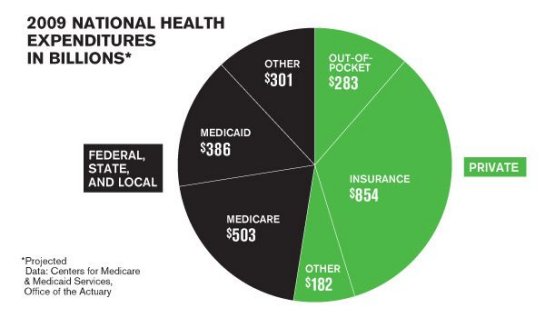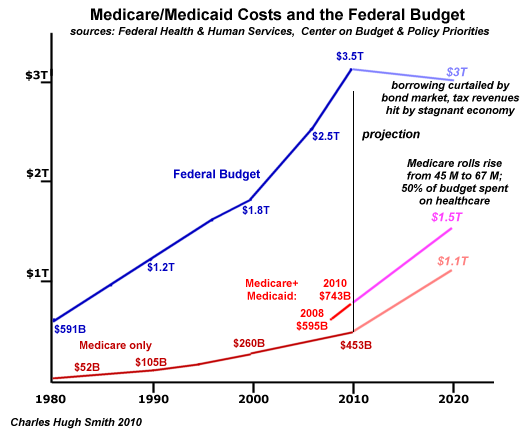Demographics and the End of the Savior State
by Charles Hugh Smith
That the Savior State appeared sustainable was an accidental coincidence of cheap oil and favorable demographics. The notion that a central government could provide cradle-to-grave care for all its citizenry was only possible when the worker-to-retiree/recipient was on the order of 10-to-1 or 5-to-1. Now that it is effectively 2-to-1 in most of the developed world, the demographics have turned decidedly unfavorable.
Correspondent Michael M. submitted this report on taxes and demographics in Germany, the Eurozone's largest economy and the world's biggest exporter.
Regarding your article Why the Eurozone Is Doomed, I want to add some insights from myself growing up in Germany, and being still in close contact to friends during the time 1996 to 2007, when I lived in Switzerland.You are absolutely right about the huge trade surplus and Mercantilist implications for Germany.
The funny thing is that almost no working person in Germany will tell you that he/she feels things have improved or at least stayed the same level since about 1999.
Since the reunification 1989 and the Eastern Germany bailout, after a short sugar-high due to government spending, things were pretty slow in the nineties. Faint off-com bubble burst.
Meanwhile, phased in from 1999 to 2003, the Oekosteuer (ecological tax) increased the tax on gasoline by about 17% at that time (15 Euro-cents per liter) - but in fact the money was taken to subsidize the already collapsing Rentenkasse (Social Security, the only pension source for the majority of German retirees).
In 2007 the VAT was increased from 16% to 19% to "cut the budget deficit", but in effect once again mainly for the Rentenkasse.
The Rentenbeitragssatz, that's the percentage that is taken directly from your income to put into the Rentenkasse, has now reached 19.9%! (on the first 6800 Euro monthly income.) But still this has to be subsidized by the Oekosteuer and *on top of that* by 20% of the federal budget, a percentage which is growing.
Now take a guess why German employees felt no benefits from productivity gains and trade surpluses of the last 10 years. Actually almost all of them feel slowly squeezed.
One additional point about demographic stress in Germany:
Since 1970 the birthrate has been close around 1.35 (no misprints here). In other words within a generation or over 35 years (as people on average are older when having kids these days), the German population shrinks by a third!
But then why hasn't the German population started really declining so far, I hear you ask. Two reasons: rising life expectancy and --for a while-- immigration. (In the last years immigration has gone down a lot.)
Have you ever heard about the German phrase, best translated to "controlled renaturation" ("kontrollierter Rückbau"). It's a euphemism for controlled demolition. It was invented for tearing down the socialist-erected living quarters in East Germany ("Plattenbauten"), in which no one wanted to live any more after the reunification. But it is effectively being applied to many parts of east *and* west Germany nowadays, closing schools for lack of pupils and so on.
Thank you, Michael, for a thought-provoking commentary on this critical topic.
We can conclude that whatever real growth (i.e. adjusted for inflation) Germany has experienced in the past 15 years, most of it has simply gone into the bottomless black hole of Social Security spending for an increasingly aging populace.
Germany is not alone in its demographics. One of the saddest images I retain from my first trip to Japan in 1992 was a rural school, abandoned for lack of students. While this might be attributed to the movement of young people from the countryside to the cities, it also reflects Japan's low birth rate.
Here in the U.S. the trends are just as irreversible. Though the U.S. maintains a "replacement" birthrate of around 2.0 live births per female, as unemployment continues rising then it's difficult to see how immigration can continue adding new taxpaying citizens: if there are no jobs, the incentive to come to America dissipates.
Medical costs continue climbing far faster than the population or GDP. Sickcare already absorbs some 17% of the U.S. economy, a staggering sum which rises 7-10% annually regardless of recession, "cost savings," new technology" and any other factor which is supposed to "save" the system.

This chart is a few years old and "official," so it reflects all sorts of hopeful extrapolations (GDP rises at 3% forever, etc.). From the present, we can already say the "crisis" foreseen in 2030 is already here: Social Security payroll taxes no longer cover Social Security costs.

Federal borrowing and debt are almost tracking this exponential curve:

As interest rates and crushing structural deficits rise, interest on the Federal debt will absorb half the Federal budget:

Medicare and Medicaid will soon take half the Federal budget:
Why the "Nascent Recovery" Won't Last (April 27, 2010)
Healthcare "Reform": the State and Plutocracy Stripmine the Middle Class (Again) (November 9, 2009)

So if interest takes half the budget, and Medicare/Medicaid take the other half, then what's left for Defense/global Empire? Zero. Social Security? Zero. Highways? Zero. Education? Zero. And so on: zero for any other spending.
There is simply no way to reconcile these numbers: there may well be fewer than 120 million people with paying jobs in a few years, even as retirees drawing Social Security and Medicare total 67 million people. Add in millions drawing Medicaid (for low-income residents without healthcare insurance), 40-50 million people drawing food stamps, millions of veterans and their spouses receiving Veterans Administration benefits, etc. and you realize the demographic pyramid has inverted: each worker will be carrying one recipient of Federal (Savior State) benefits.
That is unsustainable.
I have often addressed the decline of paying work:
End of Work, End of Affluence I: Cascading Job Losses (December 8, 2008)
End of Work, End of Affluence III: The Rise of Informal Businesses (December 10, 2008)
Endgame 3: The End of (Paying) Work (January 21, 2009)
For more on the perverse partnership of the financial Power Elites and the Savior State, and the End of Work, please take a look at Survival+: Structuring Prosperity for Yourself and the Nation and/or Survival+ The Primer.
| Thank you, Anthony M. ($25), for your extremely generous contribution (one of many) to the site. I am greatly honored by your ongoing support and readership. | Thank you, Dan T. ($10), for another most generous donation to the site. I am greatly honored by your continuing support and readership. |



























